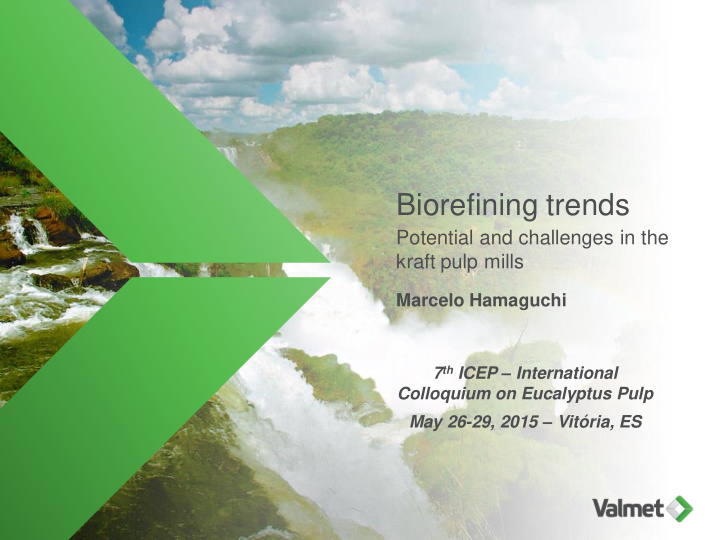



Biorefining trends Potential and challenges in the kraft pulp mills Marcelo Hamaguchi 7 th ICEP – International Colloquium on Eucalyptus Pulp May 26-29, 2015 – Vitória, ES
Focus of R&D in transition Wood Pulp Woodhandling Fiber Processing line extracted biomass drying chips esterification, tall oil white biodiesel black liquor pre-hydrolysis, hydrogenation liquor liquefaction hemicellulose extraction Recovery Evaporation Recausticizing pyrolysis Boiler lignin removal lime cycle conversion SE, torrefaction Steam Lime Kiln heat, power turbine chemicals, bio-oil lignin biofuels pelletizing gasification green liquor Auxiliary gasification fossil biofuel heat, boilers fuels power upgrading synthesis / catalytic upgrading traditional pulp mill heat, alternative technologies power transport DME,CH 4 ,H 2, fuels ethanol,FT-fuel wood: well-developed logistics, availability the year around, foreseeable cost Important to avoid any kind of disturbances in the existing operation
Opportunities ahead Valorization of biomass components Sugar SE pellets/ Transportation Advanced platform/ Lignin biocoal fuels materials chemicals Bioethanol Replacement for Monosaccharides BTX Carbon fiber Isobutanol fossil coal Furfural Binders Polysaccharide films Levulinic acid Biodiesel Dispersants Biopolymers Formic acid Aviation fuel Carbon fiber Nanocellulose Xylitol PU foams n-butanol Activated carbon
Sugars platform
Pretreatment Disrupt the crystalline structure of cellulose Feed capacities up to 1200 odt/d Ash content, including sand (erosion) Stable feeding at high pressure, filtration efficiency
Biomass fractionation – sugar platform Enzyme route Biomass Pre- Enzymatic Biomass Separation hydrolysis handling treatment Hemicellulose sugars Separation Glucose Lignin products On-site Conversion refining Biomass boiler Lactic acid Glycols Bioplastics, polymers, PET PLA
Several technologies pre- Biomass separation hydrolysis Glucose treatment Pre-treatment Ethanol/water, liquor catalyst hemicellulose sugars solvent hydrolysis, separation recovery Lignin Fiber raw Dissolving Pre- Extraction Cooking material pulp treatments Separation Bleaching Hemicellulose sugars Chemical recovery
Potential use of C5 sugars Case study Water/acid Cel: 45% Cel: 54.5% Hem: 25% Hem: 8.5% Pretreatment and Lig: 27% pretreated Lig: 35.5% Biomass Others: 3% biomass Others: 1.5% waste Separation Dry flow: 250 t/d Dry flow: 182 t/d Moisture: 45% Moisture: 60% HV: 17 MJ/kg (dry) HV: 18.1 MJ/kg (dry) Xylose (olig + mon): 35 t/d Steam from boiler: 85 t/h Steam from boiler: 104 t/h 12000 t/a Mill power generation: 137 MW Mill power generation: 142 MW
Lignin platform
Important to study the impacts H 2 SO 4 CO 2 Precipitation Dewatering Conditioning Dewatering & washing Lignin Evaporation plant Example: Removal of 25,000 t/a of lignin (~5% of total lignin) Unit Current mill data With LignoBoost Recovery boiler steam generation kg/s 188.0 181.1 Mill power generation MW 141.7 135.6 Black liquor heating value MJ/kg 14.0 13.8 Black liquor dry solids to boiler t/d 4315 4240 Estimated CO 2 consumption t/d - 17.0 Estimated H 2 SO 4 consumption t/d - 15.5
LignoBoost lignin purity development Value >99% • S-removal • Membrane 96-98% filtration of BL • Fractionated lignin feed to LB • Certain Mw? • Could be 96-98% • Depolymerisation fractionated as well • Double washed • Hemi removal 94-96% • Fuel grade lignin • pH adjusted – Neutral water Degree of refining wash
Lignin potential purity More challenging fractionated lignin sugars kraft lignin lignosulphonates Depolymerization Syringaldehyde thermal Fractionation Phenolic resins biological e.g. organosolv Vanilin thermochemical etanol 2G Activated Carbonization and Kraft pulping with carbon Biomass activation lignin extraction Spinning Sulphite pulping Stabilization Carbon < 7 USD/kg Carbonization fibers Surface treatment Lower cost CF made with lignin can be used for e.g insulating PAN-CF that do not require the strength dual-binnacle cockpit with a carbon-fiber bulkhead
Everything seems nice but....
Why not moving forward at faster pace? Diffusion not easy… User resistance to new technologies – Better quality doesn’t mean changing the user perception / satisfaction – Lack of public understanding High investment cost for novel technologies – Drivers: enough to be green? Political inactivity and also a powerful fossil fuel lobby – Decision delays can chill investments Biotech rulemaking In extreme cases: Intellectual property goes to Supreme Court and ownership remains unsolved. – Market in general is less likely to accept new products if there is only a single technology provider. Several announcements....Probably not all are going to hit the target!
Path to commercial scale plants Gartner Hype Cycle http://www.gartner.com/technology/research/methodologie s/hype-cycle.jsp
What could be done? More incentives and policy stability – PAISS : Only 5% (R$ 250 million) in the form of subvention > slow down local R&D. – Government can support more, e.g. through PNPC. Policy favoring the consumption of bio-based products – E.g. part of the increased blend % of ethanol in gasoline could come from E2G – Long term commitment Dedicated funding for specific applications – Biomaterial for automotive industry – Biofuel for jet fuel, etc
Partnership Joining forces, sharing risks / costs Feedstock Technology supplier supplier downstream : Chemical industry e.g. enzymes, yeasts Forest/agro Biomaterial industry Technology supplier industry front-end : Biofuel industry Biomass handling, Technology pretreatment provider Ex: Fortum, UPM and Valmet jointly developing a new technology to produce advanced high value lignocellulosic fuels via catalytic pyrolysis technology. Association to support the new business (e.g. ABBI to improve biotech regulations, increase technology competitiveness, etc)
Summary Wood: well-developed logistics, low ash content, availability the year around and foreseeable cost Biorefining equipment have been reaching good levels of maturity. However, full processes are still being demonstrated Valorization routes for lignin, sugars and bio-oil are indispensable steps for biorefineries to achieve payback more rapidly Feasibility influenced by feedstock quality, oil/electricity sales price, biomass availability, scale and process maturity/efficiency. Need for more consistent government policies, but also people’s attitude towards a more sustainable economy
Thank you!
Recommend
More recommend